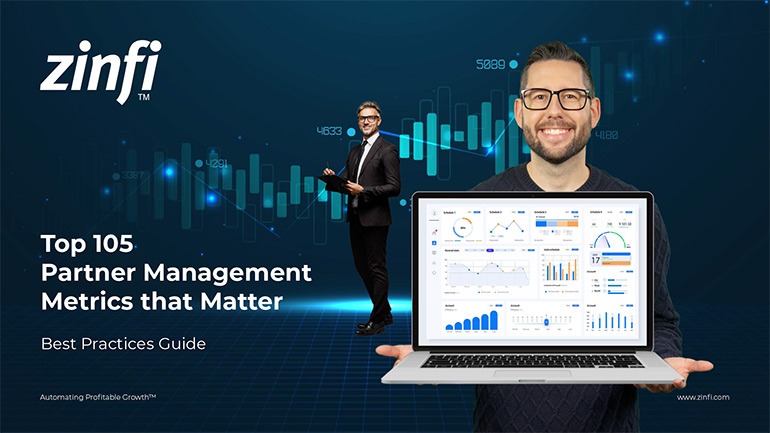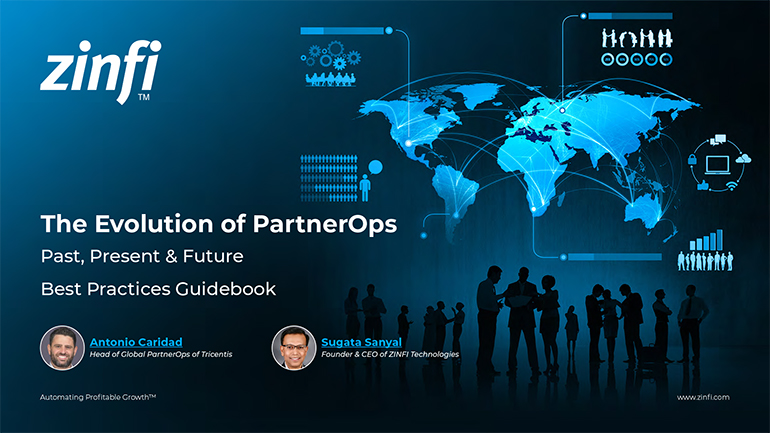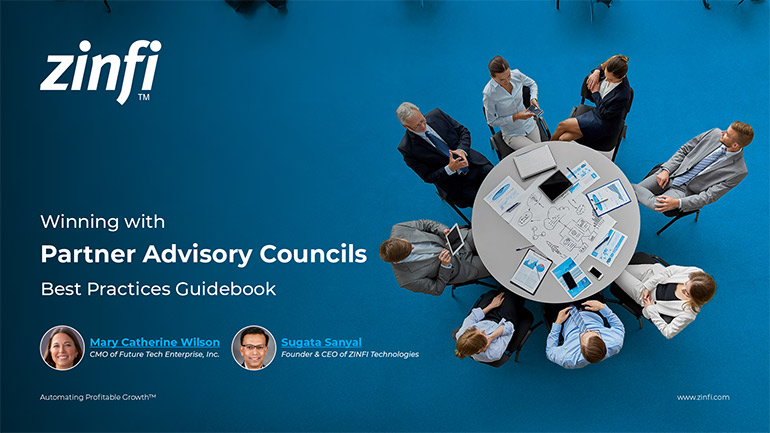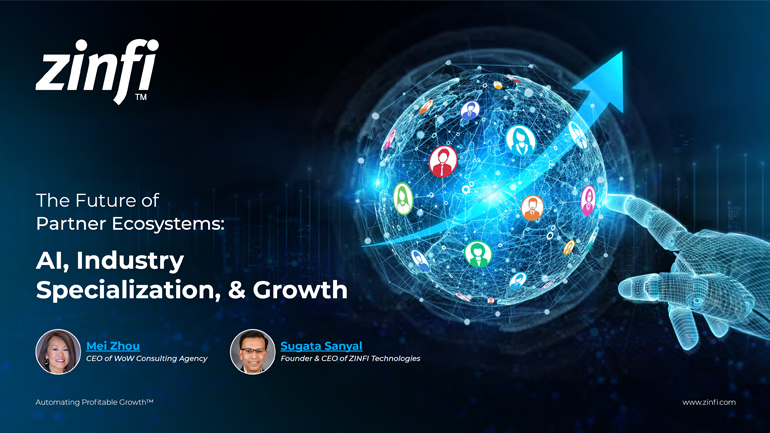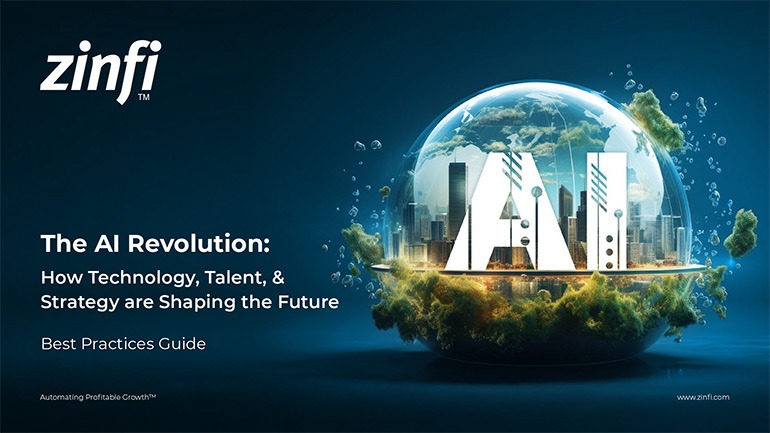

- Panel 1: AI Investment Trends for the Next 3-5 Years
- Panel 2: AI’s Role in the Customer Lifecycle & Sales Models
Panel 1: AI Investment Trends for the Next 3-5 Years
AI Investment Trends for the Next 3-5 Years
This expert panel discussion, moderated by Sugata Sanyal, Founder and CEO of ZINFI Technologies, explored AI’s impact on education, research, and enterprise adoption. Sugata, an industry leader in partner ecosystems and AI-driven SaaS solutions guided the conversation with distinguished panelists to examine AI’s role in reshaping talent pipelines, research methodologies, and business innovation.
The panel featured Dr. Jamie Payton, Dean of Ying Wu College of Computing at NJIT, who has led significant AI and cybersecurity initiatives in academia, securing over $30 million in NSF funding for computing access and diversity. Raj Sabhlok, a former executive at Zoho and Pipedrive and now a venture capitalist at Bessemer Venture Partners, discussed AI’s role in shaping investment trends and startup growth. Ed Wozencroft, NJIT’s CIO, shared insights on AI’s integration into higher education, enterprise IT, and digital transformation strategies.
Together, the panelists explored AI’s transformative role in education, the evolving workforce landscape, and enterprise AI adoption. Discussions covered AI-driven teaching methodologies, ethical considerations, and how universities and businesses can navigate the rapid acceleration of AI innovation.
Panel Focus: AI Investment Trends for the Next 3-5 Years
AI adoption in education is revolutionizing how students learn and how professionals upskill for an AI-driven workforce. Schools and universities are incorporating AI-powered tools to personalize learning experiences, providing students with tailored content and real-time feedback. AI-driven adaptive learning platforms make education more accessible, enabling students to learn at their own pace. As AI adoption expands, the education sector must ensure that AI literacy becomes a fundamental part of curricula at all levels.
Beyond traditional education, AI adoption transforms workforce development by upskilling professionals in AI-related fields. Organizations are investing in AI training programs to equip employees with the skills to thrive in an AI-powered world. From data science and machine learning to AI ethics and governance, businesses recognize that AI adoption requires a workforce that understands how to implement and manage AI systems. Upskilling initiatives are essential for bridging the AI talent gap and ensuring employees remain competitive in the job market.
The rise of AI adoption also presents challenges in workforce transformation. While AI automates repetitive tasks, it also creates demand for new skill sets, shifting the nature of work across industries. Governments and businesses must collaborate to design policies that promote AI-driven job creation while supporting workers affected by automation. AI adoption should be seen as an opportunity to enhance human potential rather than replace it, ensuring a balanced approach to workforce evolution.
AI adoption is accelerating across industries, with enterprises, governments, and venture capitalists making substantial investments. Over the next 3-5 years, AI funding will focus on enhancing automation, improving data analytics, and integrating AI into everyday business operations. Governments worldwide are investing in AI infrastructure to stay competitive, with policies fostering innovation while ensuring responsible AI use. These investments shape the foundation for long-term AI adoption, driving technological and economic transformations.
One of the most critical aspects of AI investment is its role in national competitiveness. Countries like the United States, China, and the European Union heavily fund AI research to maintain leadership in key areas such as cybersecurity, healthcare, and defense. As AI adoption grows, governments prioritize AI literacy and workforce development to ensure their economies remain agile. The ability to innovate quickly while implementing ethical AI frameworks will determine how AI reshapes global power dynamics in the coming years.
The private sector also leads the charge in AI investment, with major technology firms and startups working on groundbreaking AI solutions. Companies increasingly integrate AI into their core operations, from supply chain optimization to customer engagement. AI adoption in businesses is no longer a luxury but a necessity, and organizations that fail to adapt risk falling behind. The next wave of AI investment will focus on scalable, enterprise-grade AI solutions that deliver measurable value while maintaining transparency and compliance.
The foundation of AI adoption lies in cutting-edge research that continuously pushes the boundaries of what technology can achieve. Universities, research institutions, and private companies are at the forefront of AI innovations, exploring deep learning, reinforcement learning, and generative AI. Breakthroughs in natural language processing (NLP) and computer vision have already transformed multiple industries, from healthcare to finance. As research funding increases, the next generation of AI solutions will focus on improving efficiency, decision-making, and human-AI collaboration.
One of the most promising developments in AI research is the shift towards more explainable and ethical AI models. AI adoption has faced skepticism due to bias, transparency, and concerns about decision-making accountability. Researchers are now prioritizing fairness and interpretability in AI models, ensuring that AI-driven decisions can be understood and audited. This focus on ethical AI will be crucial as industries integrate AI into high-stakes environments, such as medical diagnostics and legal decision-making.
The commercialization of AI research is another key factor driving AI adoption. While universities and research labs develop innovative AI models, startups and tech giants are bridging the gap between theory and real-world applications. Enterprises will adopt AI based on how effectively they translate these innovations into scalable, cost-effective solutions. As AI research evolves, businesses that leverage the latest advancements will gain a competitive edge in an increasingly AI-driven economy.
The rapid pace of AI adoption in enterprises is reshaping how businesses operate, from automating workflows to enhancing customer engagement. Companies are integrating AI into various functions, including sales, marketing, HR, and supply chain management. AI-powered automation enables businesses to reduce costs, improve efficiency, and scale their operations. As AI adoption matures, organizations must develop strategies to maximize AI’s potential while mitigating risks such as bias and security concerns.
Market trends indicate that AI adoption is no longer limited to large tech firms—companies across all industries are leveraging AI to stay competitive. From healthcare to manufacturing, AI-driven solutions optimize processes, improve decision-making, and drive innovation. The democratization of AI tools allows smaller businesses to implement AI-driven strategies, accelerating AI adoption across the market. However, enterprises must navigate AI ethics, regulatory compliance, and data privacy challenges.
One of the biggest challenges in AI adoption is bridging the gap between AI research and real-world implementation. Many enterprises struggle to deploy AI solutions effectively due to issues related to data quality, scalability, and integration with existing systems. Businesses that successfully align AI adoption with their long-term goals will gain a significant advantage. Future market trends will focus on AI solutions that are not only powerful but also user-friendly, ensuring seamless AI integration at all levels of an organization.
AI adoption is reshaping the workforce by automating repetitive tasks while creating new job opportunities. While concerns about job displacement persist, history has shown that technological advancements often lead to the emergence of new industries and roles. AI-powered automation is increasing efficiency, allowing human workers to focus on higher-value tasks that require creativity, critical thinking, and emotional intelligence. Organizations that embrace AI adoption while investing in workforce development will thrive in the AI-driven economy.
The demand for AI talent is growing, with businesses seeking professionals skilled in machine learning, data science, and AI governance. AI adoption requires specialized roles such as AI ethicists, prompt engineers, and AI compliance officers. However, organizations must address the significant skills gap through targeted training programs. Educational institutions and businesses must collaborate to develop curricula that align with industry needs, ensuring a steady pipeline of AI-ready professionals.
Organizations should view AI adoption not as a threat to jobs but as an opportunity for workforce transformation. Governments and enterprises must focus on reskilling initiatives that help employees transition into AI-related roles. By fostering a continuous learning and adaptability culture, organizations can ensure that AI adoption enhances, rather than displaces, human potential. Successfully integrating AI and human intelligence will define the future of work, creating a more dynamic and innovative workforce.
As AI adoption accelerates, ethical considerations and governance frameworks are becoming increasingly important. AI’s potential to influence decision-making in critical areas such as healthcare, finance, and law requires strict guidelines to ensure fairness and accountability. AI regulations are evolving rapidly, with governments worldwide developing policies to address bias, privacy, and security concerns. Ensuring responsible AI adoption is crucial to maintaining public trust and preventing unintended consequences.
AI governance plays a pivotal role in balancing innovation with regulation. While AI adoption drives efficiency and competitiveness, organizations must implement it with safeguards to prevent misuse. Companies are establishing AI ethics boards and compliance teams to oversee AI deployment and mitigate risks. Transparency in AI algorithms and decision-making processes is essential to prevent biases that could disproportionately impact specific groups. Ethical AI adoption requires ongoing collaboration between regulators, businesses, and researchers.
The future of AI adoption will be shaped by global regulatory trends, with different regions taking varied approaches to AI governance. The European Union is leading the way with comprehensive AI regulations, while the United States and China are developing their frameworks. Organizations must stay ahead of these regulations to ensure compliance while continuing to innovate. The key to responsible AI adoption is developing standards prioritizing technological advancement and ethical integrity.
Panel 2: AI’s Role in the Customer Lifecycle & Sales Models
AI’s Role in the Customer Lifecycle & Sales Models
AI investments drive enterprise transformation, automation, and market expansion across industries. Initially focused on content generation, AI is now evolving into task automation and orchestration, integrating seamlessly into enterprise workflows. Companies like Zoom, Salesforce, and Microsoft are embedding AI into sales, service, and marketing functions, enhancing efficiency and decision-making.
AI adoption varies across enterprise sizes and regions. While U.S. companies prioritize rapid AI deployment, European firms emphasize ethical considerations and governance. Due to their agility, mid-market companies are adopting AI faster than large enterprises, which face bureaucratic and data governance hurdles.
AI investments are also reshaping partner strategies. Instead of relying on large SIs, businesses are partnering with more minor, agile consultancies that can quickly integrate AI into workflows—additionally, marketplaces like AWS, Azure, and Salesforce AppExchange fuel AI adoption by enabling seamless integrations.
As AI-driven automation accelerates, companies must balance innovation with human connection, ensuring AI complements rather than replaces relationship-driven functions like sales and partner management. The next wave of AI investments will focus on cross-functional AI agents, enterprise-wide automation, and scalable, domain-specific AI solutions to drive long-term efficiency and market competitiveness.
Panel Focus: AI’s Role in the Customer Lifecycle & Sales Models
AI investments are transforming enterprise adoption, particularly in tools that enhance productivity and collaboration. The discussion highlighted how AI-powered applications like Grammarly and GPT-based tools are increasingly used for personalized engagement. A case study demonstrated how generative AI improved email open rates from 2% to 16% by analyzing user interactions.
The session also traced the evolution of conversational AI, starting with early investments in 2016-2017, when AI was not mainstream. Solvi, a startup focused on AI-driven customer support, pioneered large language models (LLMs) before its acquisition by Zoom in 2022. Post-acquisition, Zoom shifted toward becoming an AI-first company, investing heavily in AI-driven contact center solutions.
The rapid growth of AI adoption was evident with Zoom’s AI Companion, launched in 2023. Initially adopted by 1 million businesses in 12 months, its user base skyrocketed to 6 million within the next 90 days. This growth underscores a shift from single-use AI applications to cross-functional AI integration across platforms.
AI investments will continue to focus on embedding AI into workflows, enabling automation across multiple applications, including third-party tools. This marks a fundamental shift from early AI models to generative AI solutions that enhance enterprise efficiency and decision-making.
AI investments are shaping adoption trends differently across regions and business sizes. The U.S. leads with an innovation-driven approach, rapidly integrating AI technologies, while Europe emphasizes ethics and regulatory considerations, ensuring AI’s impact aligns with societal values.
In enterprise settings, AI adoption faces regulatory and policy-driven restrictions. Large corporations implement strict governance over AI tools, limiting employee flexibility in leveraging AI-driven automation, transcription, and analytics. These guardrails, while ensuring compliance, slow down rapid AI experimentation.
Conversely, mid-market companies exhibit greater flexibility in AI integration due to fewer formal policies. Employees freely explore AI tools, sometimes leading to highly innovative implementations. However, the lack of governance raises concerns, especially regarding regulatory compliance like GDPR in Europe.
As AI investments accelerate, businesses must balance innovation and ethical responsibility. Enterprises must refine governance frameworks to allow controlled AI adoption without stifling progress, while mid-market companies need to establish policies that prevent regulatory breaches.
The discussion underscores that AI’s future lies in embedding intelligence seamlessly into workflows while maintaining compliance. As AI moves from standalone applications to cross-functional, enterprise-wide integrations, innovation and regulation will play key roles in shaping its long-term success.
AI investments accelerate enterprise transformations, with Salesforce leading the charge through its AI-driven Agent Force initiative. Launched after the 2024 Dreamforce event, Agent Force integrates AI across various Salesforce clouds, starting with Service Cloud in October and expanding to Sales Cloud in December. Future iterations will cover marketing and commerce.
Salesforce’s AI investments focus on proof-of-concept (POC) deployments, showcasing use cases that enhance customer service and sales. In service operations, AI-driven features include automated order summarization, FAQ digitization, and account summaries. These solutions help service centers improve personalization, reduce call volumes, and increase first-call resolutions, leading to significant ROI through efficiency gains.
On the sales side, AI investments enable predictive opportunity scoring, next-best-action recommendations, and AI-driven summarization of client interactions. AI-generated insights help sales teams personalize outreach, optimize engagement strategies, and save time by automating manual data compilation.
Salesforce’s AI deployment strategy extends globally, with different adoption patterns across regions. While AI governance varies, organizations increasingly look to embed AI into daily workflows rather than treating it as a separate function. As AI investments continue, the next frontier includes seamless AI integrations across third-party applications, further amplifying efficiency and productivity in enterprise environments.
AI investments are significantly reshaping marketing, partner enablement, and accessibility. As large ecosystems like Microsoft, AWS, HP, and HubSpot integrate AI, organizations align their strategies to educate partners and prepare them to sell AI-driven solutions to CIOs.
In marketing, AI is revolutionizing content creation. Generative AI, particularly ChatGPT, is enhancing efficiency, but rather than replacing writers, it empowers those who leverage it. Marketers use AI as an ideation tool, refining AI-generated content to align with brand voice and audience needs. Specific prompts improve AI output, helping create engaging and personalized content while maintaining quality control.
Beyond content, AI investments enhance team collaboration. AI tools help product marketing, content marketing, and demand generation teams align their objectives, streamlining workflows and improving cross-functional efficiency.
AI’s impact extends to accessibility, particularly in education. Tools like Perplexity and Speechify assist individuals with dyslexia, leveling the playing field for learning. Personal experiences highlight how AI-driven assistive technologies reduce the need for costly interventions and empower students to overcome learning challenges.
Overall, AI investments are transforming enterprise marketing strategies, workplace collaboration, and accessibility, proving that AI is not just about automation but also about enabling better human experiences.
AI investments drive enterprise adoption at different speeds, depending on use cases. Zoom’s AI Companion experienced a surge from 1 million to 6 million users as organizations recognized AI’s impact on mission-critical operations like sales and customer service.
Enterprise AI adoption follows a structured decision-making process, often requiring lengthy approvals. A Fortune 3 bank took 12 months and 17 meetings to approve AI adoption for general workflows. In contrast, the same company approved AI for its contact center in just three meetings over one month due to immediate ROI in sales and customer interactions. AI’s ability to improve key performance metrics—such as first-call resolution and average handle time—accelerates decision-making.
AI investments are also shifting power dynamics in organizations. CIOs are becoming central decision-makers in AI adoption, acting as AI strategists who must either build or license AI-powered solutions for various departments. This trend highlights the need for businesses to strengthen relationships with CIOs, as they will play a crucial role in shaping AI-enabled operations.
Ultimately, AI investments succeed when AI is embedded directly into existing workflows. Companies that integrate AI into sales, customer service, and business processes see faster adoption and immediate value, while those focusing on broader applications must navigate complex governance and regulatory hurdles.
AI investments are transforming partner lifecycle management, particularly for mid-market companies looking to scale. AI plays a key role in automating partner acquisition, onboarding, and engagement, streamlining traditionally manual and time-consuming processes.
AI functions similarly to a sales development rep (SDR) in partner acquisition, automating outreach, and personalizing messaging. AI-generated insights help refine communication, improving response rates and engagement. However, the real power of AI lies in enabling human connection rather than replacing it. By handling repetitive tasks, AI allows partner managers to focus on building deeper relationships.
AI investments also enhance partner management by automating administrative tasks, transcribing calls, summarizing conversations, and preparing follow-ups. Intelligent call recording software, for example, tracks past interactions and suggests personalized conversation points, making relationship-building more natural and effective.
However, a key challenge is ensuring AI is used as a learning tool rather than a shortcut. Experienced professionals can validate AI-generated recommendations, but younger professionals risk over-relying on AI without critical evaluation. This can lead to ineffective messaging and weakened relationships.
Ultimately, AI investments should focus on augmenting human capabilities rather than replacing them. Companies that use AI to enhance, rather than replace, relationship-building will see the most success in their partner management strategies.
AI investments are reshaping partner lifecycle management and customer engagement, enhancing efficiency while raising concerns about human connection. In partner management, AI streamlines acquisition, onboarding, and co-selling by automating outreach and personalizing communication, similar to an SDR function. AI-powered messaging and administrative automation allow partner teams to focus on relationship-building rather than repetitive tasks.
However, AI’s success depends on its application. While AI can free up time for human connection, misuse may result in over-reliance, where AI is used to “do” rather than “learn.” Younger professionals risk becoming dependent on AI-generated recommendations without validating accuracy or strategic alignment. The key lies in using AI as a support tool, ensuring human oversight in decision-making.
AI investments in customer engagement also show promise. Personalized AI-driven interactions could replace frustrating, repetitive service experiences. For instance, AI can integrate omnichannel data to recognize a returning customer’s recent web activity and proactively offer solutions, enhancing satisfaction and loyalty. However, businesses have yet to realize this vision fully.
To maximize AI investments, companies must balance automation with human touchpoints. AI should enhance—not replace—relationship-driven roles, ensuring meaningful partner collaboration and customer experiences. The future lies in leveraging AI for operational efficiency while maintaining authentic, trust-based interactions.
AI investments are transforming partner marketing by shifting focus from traditional event-driven strategies to intelligent, data-driven engagement. Historically, companies have allocated around 2% of revenue to Market Development Funds (MDF), with a significant portion spent on events. However, these efforts often fail to generate tangible leads. Instead, AI-driven tools are emerging as a more practical alternative for partner enablement.
AI agents are now playing a crucial role in prospect engagement. By leveraging AI-powered LinkedIn automation, partners can enhance outreach, personalize messaging, and build stronger connections. AI-driven tools can analyze prospect behavior, align conversations with personal interests, and improve engagement rates. This personalized approach increases the likelihood of meaningful business relationships compared to traditional event networking.
Beyond outreach, AI investments are reshaping digital visibility. Instead of relying solely on SEO, companies must feed AI models with brand information to ensure their products and services are prioritized in AI-generated search results. This shift in strategy is critical as AI-driven recommendations become a primary discovery method for potential customers.
Additionally, AI enables partners to leverage advanced digital marketing tactics, such as geofencing and hyper-targeted digital ads, to engage prospects continuously. As AI investments grow, businesses must embrace AI-powered marketing strategies to remain competitive in the evolving partner ecosystem.
AI investments in enterprise sales face challenges due to lengthy adoption cycles, often requiring multiple meetings and extensive approval processes. To accelerate AI adoption, vendors must shift their approach by focusing on three critical factors: measurable impact, workflow integration, and data quality.
First, AI vendors must present clear, specific, and provable ROI metrics instead of generic time-saving claims. Many CIOs are overwhelmed with vendors claiming productivity improvements, making it essential to demonstrate measurable results upfront.
Second, AI adoption is often hindered by poor data infrastructure. While AI models and agent capabilities advance rapidly, organizations struggle with unclean data. Vendors should proactively assist enterprises in bridging the data gap by offering tools and strategies to improve data readiness. This enables AI applications to deliver tangible value sooner.
Third, security, governance, and compliance remain top priorities for enterprises. Companies want to know how AI vendors handle data, whether it is used for model training, how outputs are stored, and what third-party integrations are involved. Providing transparent security and governance documentation before meetings can streamline the decision-making process.
By leading with clear ROI, addressing data challenges, and ensuring security transparency, AI investments can achieve faster enterprise adoption, reducing sales cycles and maximizing impact.
AI investments shift from point solutions to more comprehensive, cross-functional enterprise applications. AI adoption in enterprises primarily focuses on specific use cases, such as CRM and service-related tasks, rather than fully integrated workflows. Like early Dropbox adoption, AI traction is stronger in individual user-specific applications than in collaborative cross-functional processes.
Salesforce’s AI strategy, for instance, is currently centered around targeted automation through its “agent-first” approach, helping users within CRM and service functions. However, the next phase of AI evolution will involve “super agents”—advanced AI models capable of coordinating across multiple applications, reasoning with different AI agents, and maintaining memory for more seamless workflows.
Despite the potential, enterprises remain hesitant to consolidate AI layers within platforms like Salesforce due to data silos across different systems. Instead, companies look to multimodal AI platforms above their existing applications and dynamically pull data as needed.
While this transition is inevitable, the timeline for full-scale implementation remains uncertain, with broader adoption expected in the coming years. AI investments will increasingly focus on integrating disparate data sources, ensuring interoperability, and enabling AI-driven decision-making across entire enterprises rather than within isolated systems.
The complexities of AI adoption in large enterprises are prompting mid-market companies to rethink their go-to-market strategies. Traditionally, startups and mid-sized firms aimed to partner with large distributors like Microsoft, HP, or other enterprise giants to scale their products. However, AI implementation in enterprises faces significant barriers, including data silos, governance constraints, and slow adoption cycles.
Given these challenges, a shift towards targeting smaller partners within larger ecosystems—the “long tail” of enterprise partners—may provide a faster path to market penetration. Smaller, agile partners are more likely to adopt AI-powered tools quickly, creating a network of hundreds of AI-enabled sellers rather than relying on slow-moving enterprise adoption.
The financial aspect also plays a role. Enterprise payment cycles are significantly longer, often extending beyond 120 days post-invoice approval, making them less attractive for companies seeking quicker returns on investment. In contrast, mid-market and long-tail partners operate with shorter sales cycles and speedier decision-making, allowing AI-driven solutions to scale faster and generate revenue sooner.
Ultimately, the choice depends on product fit, partner type, and overall market strategy. Still, AI investments are pushing mid-market companies to prioritize speed, agility, and accessibility over traditional enterprise-scale distribution models.
Companies must rethink their go-to-market strategy as AI adoption accelerates, mainly when working with partners. Large systems integrators (SIs) have traditionally been the preferred choice due to their extensive distribution networks. However, the slow adoption of AI within these organizations—caused by bureaucratic inertia, data complexity, and rigid processes—has led to inefficiencies in scaling AI-powered solutions.
Smaller regional consultancies and agile partners are emerging as the better choice for AI-driven growth. These firms move faster, upskill more efficiently, and integrate new AI tools into their offerings. Unlike large consultancies that struggle to adapt, smaller partners align with fast-evolving AI ecosystems, helping companies deploy AI-enhanced data solutions, automation, and customer engagement tools much more effectively.
For companies developing AI-driven solutions, prioritizing smaller, specialized partners over legacy SIs ensures faster implementation and adoption. These partners are more receptive to emerging AI technologies and excel at customizing solutions to meet business needs.
Ultimately, AI investments should focus on speed, agility, and scalability—key advantages that smaller partners bring. As AI reshapes data ecosystems and customer interactions, brands must pivot toward flexible, fast-moving partnerships for sustained market success.
AI investments are shifting from content generation to task completion, driving the next phase of digital transformation. In 2025, AI-powered orchestration layers will become critical, enabling businesses to automate tasks across multiple enterprise applications like Workday, Salesforce, and ServiceNow. This shift means AI will analyze and synthesize information and execute processes autonomously, improving efficiency.
Marketplaces like Azure, AWS, and Salesforce AppExchange are evolving rapidly, integrating AI-powered solutions for seamless interoperability. AI-driven task completion will require deep integration within enterprise stacks, making it essential for businesses to align their AI investments with existing platforms.
For partners and resellers, the opportunity lies in helping customers maximize AI-driven automation within their existing ecosystems. With AI companions embedded in central software stacks, companies must strategically position themselves by integrating AI solutions that enhance productivity and decision-making.
The rise of domain-specific AI tools will further expand the software-as-a-service market, leading to a proliferation of specialized AI-driven solutions tailored to niche business needs. Companies must prioritize AI investments that enable faster, more efficient task execution, ensuring seamless cross-platform integration to maintain competitiveness in an increasingly AI-powered enterprise landscape.
AI investments are accelerating the evolution of the Independent Software Vendor (ISV) ecosystem, particularly in Europe, where 30-40% of ISVs are expanding their presence alongside dominant American platform players. While messaging strategies between European and U.S. markets remain broadly similar, the emphasis is shifting toward integration within technology stacks rather than standalone functionality.
AI-powered ISVs are increasingly recognizing the importance of interoperability, focusing on their capabilities and how they enhance pre-existing and subsequent technologies within enterprise stacks. This shift is crucial as businesses seek end-to-end AI-powered solutions rather than isolated applications.
Marketplaces like AWS, Azure, and Salesforce AppExchange fuel AI adoption by providing easier integration opportunities, enabling ISVs to position themselves within broader digital ecosystems. As AI moves beyond content generation into task automation and orchestration, ISVs that highlight their ability to streamline workflows and enhance productivity will gain a competitive edge.
The future of AI investments in ISVs lies in fostering collaborative solutions that enhance the entire technology stack, driving efficiency across business functions. Companies focusing on seamless integrations, data flow optimization, and automation will be best positioned to thrive in the AI-driven enterprise landscape.


